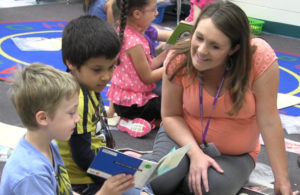By Cyndal Brenneman, first published by Real Clear Education, October 18, 2016
 What’s the recipe for an effective system of teacher leadership that can lead to higher student growth?
What’s the recipe for an effective system of teacher leadership that can lead to higher student growth?
My school, Rocky River Elementary, in Cabarrus County, N.C., ranked at the bottom of student proficiency and student growth in recent years. We clearly needed to cook up something new. So we stirred up equal parts trust-building and capacity-building with student-centered coaching and administrative support, and created a powerful stew that led to meeting student growth goals for the first time in years.
Rocky River added multi-classroom leaders and subject specialization to begin lifting student achievement. To make specialization meet its potential, teachers need to be highly effective in teaching one subject. To craft such individuals, the school needs multi-classroom leaders to help advance teachers in their subjects—and that’s where the recipe kicks in.
One part trust-building: This is an MCL’s first, most important step. I was a relatively new face on a well-established staff, and I had less experience than many on my K-1 team of 12 teachers. I tried simple steps, such as starting meetings with a smile and providing teachers with an opportunity to share something personally or professionally positive. This gave me access into their lives and let the grade-level members get to know one another better. Surprisingly, some of my colleagues who had worked together for years learned new things.
After a few weeks, I sent out a coaching survey to see which teachers would let me co-teach with them. This took away the stigma of veteran teachers being coached by a less-experienced teacher, because they chose the areas in which they wanted help. My more resistant teachers saw the work that I put into coaching others, and by midyear, they were asking me to coach them in their weaker areas.
By 2015-16, my second year with the team, I saw the trust that we built continue to grow—cooking up not just better working relationships but strong student achievement: Our kindergarten team had the highest growth in the district on the state reading and comprehension assessment, and our first-graders had an average of at least a year’s growth on the assessment, with many growing much more.
One part capacity-building: When I first applied for this job, my administrator told me that the ultimate goal was for it to be no longer needed—because all my coaching would have turned the teachers into superstars. As scary as that thought was, I realized my job is to not only affect student achievement, but also to help make teachers into instructional leaders in their classrooms and the profession.
Rocky River uses nine-week coaching cycles, putting me in a classroom two to three times each week. In each cycle, the teacher and I write and teach lessons together. I pull small groups and confer individually with students while I am in the classroom, in order to better understand them and to give the teacher the sense of “I am here with you, let’s do this together.” I try to model what’s worked for me.
After modeling or explaining a teaching practice, I observe the teacher using it and provide feedback. Finally, we tweak it to become a method that benefits students and feels comfortable for the teacher.
Along the way, even though it’s less visible, I’m coaching teachers to be leaders. I did this specifically last year with one dynamite teacher—she didn’t need classroom techniques help, but she wanted help in leading a group of teachers with planning. I coached her on how to work with different types of people and eliminate barriers to successful leadership. We had ups and downs, but by the end of the year, the teachers were working in unison.
One part student-centered coaching: It’s all about the data. Coaching cycles begin with a deep look at the teacher’s student achievement data, from which we set the goal for the cycle and beyond. Making students’ data the center of coaching helped keep teachers from feeling defensive, knowing we were working toward the same goal.
One part administrator support: Administrators play a huge role as the evaluators. I am the liaison helping mold the teachers to administrators’ vision of the school, and I share with them the goal each teacher and I have set. The administrators observe classrooms, and their support in providing me with the next steps to make the teachers the best they can be is a crucial ingredient.
When all of these ingredients come together, magic begins to take hold! For the past two years, I have had the privilege of working with a group of students from kindergarten into first grade who were struggling to make growth. I coached their teacher on guided reading strategies for them, and conducted separate group sessions twice a week. One student had not made any growth since the middle of his kindergarten year and was classified as a non-reader. But after my coaching and direct teaching, by the end of first grade he had made five levels of growth!
That’s the positive change and impact on a large number of students that makes me enjoy being an MCL. As I continue to perfect the role, I plan to rely on the developing teacher-leaders in our school to help maximize our success.
